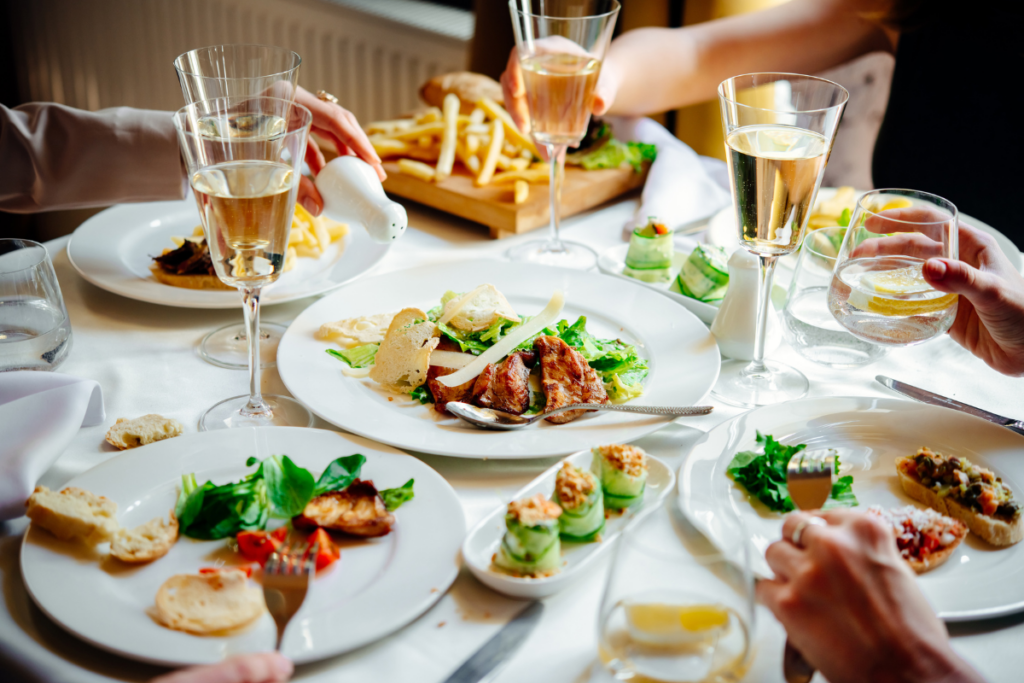Updated November 2024.
Bergen Linen is here to help you this season with our holiday party checklist!
Hosting a memorable holiday party for friends and family is the ultimate way to spread cheer. Of course, corporate and other festive events are just as special! While the idea of planning a celebration can seem daunting, it’s usually because you’re not sure where to start. Fret not! We’ve crafted the ultimate holiday party planning checklist to ensure your Christmas party or holiday event goes off without a hitch, leaving you more time to spend with party guests.
When to Start Planning Holiday Events
Bergen Linen is here to help you this season with our ultimate checklist AND throw a successful holiday party. So let’s get into the holiday spirit and start your event planning.
Holiday Party Planning Timeline
- Early Fall (around 2-3 months prior to the event)
- Determine theme, date, and time
- Research event spaces
- Establish general guest count
- 8-10 Weeks Prior
- Finalize the date, time and venue
- Design and send out party invitations
- Start brainstorming theme, party supplies, decor, and menu
- 6-8 Weeks Before
- Confirm RSVPs (and make any guest count adjustments)
- Start shopping/placing orders for decor, guest favors, etc.
- Finish hiring any necessary vendors or service such as catering company, entertainment, videographer, etc.
- 4-6 Weeks Before
- Taste test (if you haven’t already) and determine menu
- Order any remaining specialty items
- Do a final review of any specific dietary preferences or restrictions
- 2-4 Weeks Before
- Confirm arrival times
- Catering company
- Set-up crew/committee
- Videographer and photographer
- Cross-off any last to-dos
- Confirm arrival times
- 1-2 Weeks Before
- Follow up with any guests who haven’t RSVP’d
- Do a final check of all decorations, supplies, and technical equipment
-
- Review your day-of-party schedule
- Days Before
- Confirm final numbers with your catering company, venue, and/or rental provider
- Party Day
- Venue set-up
- Be ready to greet guests
Stress-free Holiday Party Checklist
Depending on the size of your holiday season event, you may want to enlist some extra hands. For larger events, party planning committees will be very helpful. Each committee should have its own lead to keep communication flowing smoothly. This will be extremely useful on the day of the party.
- Determine Your Budget
- Your budget will be your guide for everything from party size to activities.
- Set the Date and Time
- Choose a date that works for you, your guests, AND is available.
- Decide on a start and end time for the party.
- This will most likely also determine your dress code and type of party.
- If this is a work event, allow ample time for co-workers to prepare.
- Create the Guest List
- Compile a list of friends, family, or other guests you’d like to invite.
- Keep in mind your budget and event capacity.
- Choose a Theme
- Decide if you want a specific theme including dress code.
- Plan decorations, party favors, menu, and party games that align with the chosen theme.
- Send Invitations
- Send out invitations well in advance (digital or traditional).
- Include event details like the date, time, location, dress code (especially for an ugly sweater party), and RSVP information.
- Send out invitations well in advance (digital or traditional).
- Plan the Menu:
- Design a menu that caters to different dietary preferences.
- If you have a theme, be sure to include some fun menu items.
- Depending on the type of event, decide between catering, potluck-style, or DIY cooking.
- Design a menu that caters to different dietary preferences.
- Arrange the Bar
- Plan a selection of beverages, including alcoholic and non-alcoholic option. Ensure you have enough glassware, ice, and mixers.
- Set up a designated area for the bar – and decide if a bartender(s) is needed.
- Decorate the Venue
- Purchase and/or choose festive decorations that align with your chosen theme.
- This is the ideal time to place your party linen rental order. Planning a company holiday party; it would be ideal to work in your brand colors and/or logo.
- Pay attention to lighting, table settings, and other festive touches in your party space.
- Create a Party Playlist
- Even if you hire a DJ or band, it is important to decide on a general playlist.
- Be sure to include a mix of holiday classics and upbeat tunes.
- Even if you hire a DJ or band, it is important to decide on a general playlist.
- Plan Activities and Entertainment
- Organize games or other fun activities to keep guests engaged.
- Sign off on contracts for your musical entertainment such as a DJ or band.
- Look into a photo booth, photograph, or videographer.
- For work events, you may be including various speakers (internal or specialty). This may also require a podium and audio visual equipment.
- Set Up a Coat Check
- In our New York area, a holiday party will need to offer a coat check. (It is also a good time to consider the car valet situation.)
- Prepare a Backup Plan
- Crucial in party prep – be ready for unexpected changes in weather or other unforeseen circumstances.
- Review Last Minute Essentials
- Review your checklist including: entertainment, party decorations, party support, menu options, technical equipment, etc.
- Confirm RSVPs
- Follow up with guests who haven’t responded to the invitations. (You may need to let your venue or catering company know.)
- Relax and Enjoy Your Party Day
- If you have a committee or party helpers, meet with them in advance to review those finishing details.
- Once everything is set up, take a deep breath and enjoy your holiday party fun.
Making the Most of Your Memorable Event
Even with the most party preparation, some details are going to go awry. Whether it be a vendor arriving late or bad weather, you have to be very to go with the flow. Adapting is not easy, but preparing mentally ahead of time can help.
And with whatever type of holiday party you are planning, we always suggest begin researching early. By looking at ideas, you may find inspiration leads to quicker decisions pertaining to themes, venues, entertainment, and more. Questions about event linen rentals? Check out our wide selection of party rentals today.
With this comprehensive holiday party planning checklist in hand, you’re well on your way to hosting a festive and stress-free event! And if you need party linens, place your order today. A Bergen Linen team member is here to walk you through your options.





